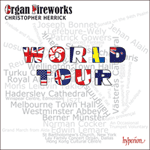Trumpet tunes are frequently found in theatre and church music of the seventeenth and early-eighteenth centuries. They were used for ceremonial occasions, royal pomp or scenes of battle and many fine examples exist by Purcell. Perhaps one of the most widely known is the prelude to the
Te Deum of Charpentier, which gained wide currency as the signature tune for the Eurovision organization. The Texan-born organist David Johnson, who was Professor of Music at Arizona State University for many years, produced no fewer than nine affectionate tributes to the genre, the present one, in D major, dating from 1962. For the solo lines he generally restricts himself to the diatonic notes which would be available on the natural trumpet while allowing a little more spice in the accompaniment. The piece is in ABA form, with each trumpet phrase of the opening section being repeated orchestrally, as it were. A contrasting middle section in the minor leads back to a reprise of the whole first section.
from notes by Stephen Westrop © 2004
Fréquents dans la musique théâtrale et liturgique du XVIIe siècle et du début du XVIIIe siècle, les «trumpet tunes» étaient utilisés lors d’événements cérémoniaux, pour la pompe royale ou les scènes de bataille, comme l’illustrent maints beaux exemples de Purcell. L’un des plus connus est peut-être le prélude du
Te Deum de Charpentier, le fameux indicatif de l’Eurovision. L’organiste texan David Johnson, longtemps professeur de musique à l’Arizona State University, ne composa pas moins de neuf tendres hommages à ce genre musical, le présent, en ré majeur, datant de 1962. Pour les lignes solistes, il se cantonne généralement aux notes diatoniques qui seraient disponibles sur une trompette naturelle, tout en s’autorisant un accompagnement légèrement épicé. La pièce, de forme ABA, voit chaque phrase de trompette de la section d’ouverture reprise orchestralement, pour ainsi dire. Une section centrale contrastée, en mineur, ramène à une reprise intégrale de la première section.
extrait des notes rédigées par Stephen Westrop © 2004
Français: Hypérion
Trompetenmelodien tauchen häufig in der Theater- und Kirchenmusik des 17. und frühen 18. Jahrhunderts auf. Sie wurden bei bestimmten Zeremonien, königlichem Pomp oder auch in Kampfszenen eingesetzt und viele besonders gute Trompetenmelodien stammen aus der Feder von Henry Purcell. Die möglicherweise bekannteste solche Melodie ist das Vorspiel zu dem
Te Deum von Charpentier, das als Erkennungsmelodie der Organisation Eurovision berühmt wurde. Der in Texas geborene Organist David Johnson, der viele Jahre lang als Musikprofessor an der Arizona State University tätig war, hat, dem Genre liebevoll nacheifernd, nicht weniger als neun solcher Trompetenmelodien geschrieben, darunter die vorliegende in D-Dur, die 1962 entstand. Bei den Solopassagen beschränkt er sich im allgemeinen auf diatonische Noten, die auf der Naturtontrompete auch spielbar wären, erlaubt sich in der Begleitung jedoch etwas mehr Würze. Das Stück ist in einer ABA-Form angelegt, wobei alle Teile von einer Trompetenphrase eröffnet werden, was dann vom „Orchester“ wiederholt wird. Der kontrastierende Mittelteil in Moll führt zu einer Reprise des ganzen ersten Teils.
aus dem Begleittext von Stephen Westrop © 2004
Deutsch: Viola Scheffel


 Organ Fireworks World Tour
Organ Fireworks World Tour
